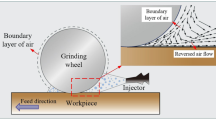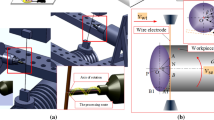Abstract
DD6 nickel-based single-crystal superalloy has been treated as an ideal material for the high-valued and high-performed aero-engine components; however, it was found difficult to remove material from the DD6 nickel-based single-crystal superalloy in cutting and grinding. Although creep-feed deep grinding (CFDG) has been widely employed for various nickel-based superalloys (i.e., Inconel 718, DZ4, IN738LC), very few efforts however have been focused on the nickel-based single-crystal superalloy. With this, this paper focuses on CFDG of DD6 nickel-based single-crystal superalloy to gain the more in-depth understandings, targeting grinding force, specific grinding energy, grinding temperature, surface integrity, and wheel wear condition. Scheduled experimental observation proved that (i) microcrystalline alumina abrasive wheel generally shows more superior grinding performances in aspect to grinding force, force ratio, and specific grinding energy than that of brown alumina abrasive wheel; (ii) grinding temperature is decreased by 35% by using the microcrystalline alumina abrasive wheel compared to brown alumina abrasive wheel, and therefore the microcrystalline alumina abrasive wheels have the potential to be applied in the high-efficiency grinding; (iii) the surface ground by the microcrystalline alumina abrasive wheel is found smooth without any grinding-induced damage; and (iv) microcrystalline alumina abrasive wheels easily lead to micro-fractures and therefore result in better self-sharpness ability and longer service life in CFDG of DD6 nickel-based single-crystal superalloy.
Similar content being viewed by others
References
Thakur A, Gangopadhyay S (2016) State-of-the-art in surface integrity in machining of nickel-based superalloys. Int J Mach Tools Manuf 100:25–54
Li HN, Axinte D (2018) On the inverse design of discontinuous abrasive surface to lower friction-induced temperature in grinding: an example of engineered abrasive tools. Int J Mach Tools Manuf 132:50–63
Li HN, Axinte D (2017) On a stochastically grain-discretised model for 2D/3D temperature mapping prediction in grinding. Int J Mach Tools Manuf 116:60–76
Saoubi R, Axinte D, Soo SL, Nobel C, Attia H (2015) High performance cutting of advanced aerospace alloys and composite materials. CIRP Ann 64(2):557–580
Jin HP, Li JR, Liu SZ (2007) Stress rupture properties of the second generation single crystal superalloy DD6 after high temperature exposure. Mater Sci Forum 546-549:1249–1252
Ulutan D, Ozel T (2011) Machining induced surface integrity in titanium and nickel alloys: a review. Int J Mach Tools Manuf 51(3):250–280
Thellaputta GR, Chandra PS, Rao CSP (2017) Machinability of nickel based superalloys: a review. Mater Today: Proc 4(2): 3712–3721
Guo C, Malkin S (1994) Analytical and experimental investigation of burnout in creep-feed grinding. CIRP Ann Manuf Technol 43(1):283–286
Yao CF, Jin QC, Huang XC, Wu DX, Ren JX, Zhuang DH (2013) Research on surface integrity of grinding Inconel718. Int J Adv Manuf Technol 65(5–8):1019–1030
Hasuda Y, Handa A, Kobori Y, Kinebuchi S, Furusawa T, Harigaya Y (2012) Grinding of super-alloys using metal-bonded CBN wheel. Key Eng Mater 523:143–148
Sinha MK, Setti D, Ghosh S, Rao PV (2016) An investigation on surface burn during grinding of Inconel 718. J Manuf Process 21:124–133
Bhaduri D, Soo SL, Aspinwall DK, Novovic D, Harden P, Bohr S, Martin D (2012) A study on ultrasonic assisted creep feed grinding of nickel based superalloys. Procedia CIRP 1:359–364
Sunarto IY (2001) Creep feed profile grinding of Ni-based superalloys with ultrafine-polycrystalline cBN abrasive grits. Precis Eng 25(4):274–283
Ding WF, Xu JH, Chen ZZ, Su HH, Fu YC (2010) Grindability and surface integrity of cast nickel-based superalloy in creep feed grinding with brazed CBN abrasive wheels. Chin J Aeronaut 23(4):501–510
Chen M, Li XT, Sun FH, Xiang YC, Xue BY (2001) Studies on the grinding characteristics of directionally solidified nickel-based superalloy. J Mater Process Technol 116(2–3):165–169
Österle W, Li PX (1997) Mechanical and thermal response of a nickel-base superalloy upon grinding with high removal rates. Mater Sci Eng A 238(2):357–366
Li JR, Zhong ZG, Tang DZ, Liu SZ, Wei P (2000) A low-cost second generation single crystal superalloy DD6. Superalloys:777–783
Ren YH, Zhang B, Zhou ZX (2009) Specific energy in grinding of tungsten carbides of various grain sizes. CIRP Ann Manuf Technol 58(1):299–302
Denkena B, Köhler J, Wang B (2010) Manufacturing of functional riblet structures by profile grinding. CIRP J Manuf Sci Technol 3(1):14–26
Li HN, Yu TB, Wang ZX, Zhu LD, Wang WS (2017) Detailed modeling of cutting forces in grinding process considering variable stages of grain-workpiece micro interactions. Int J Mech Sci 126:319–339
Liu Q, Chen X, Gindy N (2007) Assessment of Al2O3 and super abrasive wheels in nickel-based alloy grinding. Int J Adv Manuf Technol 33(9–10):940–951
Yang M, Li C, Zhang Y, Jia DC, Zhang XP, Hou Y, Li R, Wang J (2017) Maximum undeformed equivalent chip thickness for ductile-brittle transition of zirconia ceramics under different lubrication conditions. Int J Mach Tool Manu 122:55–65
Zhang Y, Li C, Ji H, Yang X, Yang M (2017) Analysis of grinding mechanics and improved predictive force model based on material-removal and plastic-stacking mechanisms. Int J Mach Tools Manuf 122:81–97
Zhang DK, Li CH, Zhang YB, Jia DZ, Zhang XW (2015) Experimental research on the energy ratio coefficient and specific grinding energy in nanoparticle jet MQL grinding. Int J Adv Manuf Technol 78(5–8):1275–1288
Zhang XP, Li CH, Zhang YB, Zhang XW (2016) Performances of Al2O3 /SiC hybrid nanofluids in minimum-quantity lubrication grinding. Int J Adv Manuf Technol 86(9–12):1–15
Guo C, Malkin S (1992) Analysis of fluid flow through the grinding zone. J Eng Ind 114:427–434
Nadolny K (2014) State of the art in production, properties and applications of the microcrystalline sintered corundum abrasive grains. Int J Adv Manuf Technol 74(9–12):1445–1457
Zhang DK, Li CH, Jia DZ (2015) Specific grinding energy and surface roughness of nanoparticle jet minimum quantity lubrication in grinding. Chin J Aeronaut 28(2):570–581
Guo C, Malkin S (1996) Inverse heat transfer analysis of grinding. J Eng Ind Part 2: Applications 118:143–149
Rowe B (2001) Thermal analysis of high efficiency deep grinding. Int J Mach Tools Manuf 41(1):1–19
Guo C, Malkin S (1995) Analysis of transient temperatures in grinding. J Eng Ind 117:571–577
Godino L, Pombo I, Sanchez JA, Alvarez J (2018) On the development and evolution of wear flats in microcrystalline sintered alumina grinding wheels. J Manuf Process 32:494–505
Ren JX, Hua DA (2011) Grinding principal. Beijing: Publishing House of Electronics Industry 131–133 [In Chinese]
Li BK, Li CH, Zhang YB, Sun K (2017) Heat transfer performance of MQL grinding with different nanofluids for Ni-based alloys using vegetable oil. J Clean Prod 154:1–11
Funding
This study was financially supported by the National Natural Science Foundation of China (51775275), the Funding of Jiangsu Innovation Program for Graduate Education (KYCX17_0245), and the Funding for Outstanding Doctoral Dissertation in NUAA (BCXJ17-04).
Author information
Authors and Affiliations
Corresponding author
Rights and permissions
About this article
Cite this article
Gu, Y., Li, H., Du, B. et al. Towards the understanding of creep-feed deep grinding of DD6 nickel-based single-crystal superalloy. Int J Adv Manuf Technol 100, 445–455 (2019). https://doi.org/10.1007/s00170-018-2686-2
Received:
Accepted:
Published:
Issue Date:
DOI: https://doi.org/10.1007/s00170-018-2686-2




